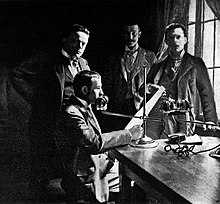Dateline : July 2, 1896: scientist Guglielmo Marconi was awarded British patent 12039, Improvements in transmitting electrical impulses and signals and in apparatus there-for, for radio.
Marconi was the first scientist to achieve successful radio transmission.In 1895, Marconi built a wireless system capable of transmitting signals at long distances (1.5 mi./ 2.4 km).In radio transmission technology, early public experimenters had made short distance broadcasts.Marconi achieved long range signalling due to a wireless transmitting apparatus and a radio receiver claimed by him. From Marconi's experiments, the phenomenon that transmission range is proportional to the square of antenna height is known as "Marconi's law."
Marconi's experimental apparatus proved to be the first engineering complete, commercially successful radio transmission system.According to the Proceedings of the United States Naval Institute in 1899, the Marconi instruments had a "[...] coherer, principle of which was discovered some twenty years ago, [and was] the only electrical instrument or device contained in the apparatus that is at all new."
In 1897, he established a radio station on the Isle of Wight, England. Marconi opened his "wireless" factory in Hall Street, Chelmsford, England in 1898, employing around 60 people. Shortly after the 1900s, Marconi held the patent rights for radio..
Marconi once said : "If we consider what science already has enabled men to know—the immensity of space, the fantastic philosophy of the stars, the infinite smallness of the composition of atoms, the macrocosm whereby we succeed only in creating outlines and translating a measure into numbers without our minds being able to form any concrete idea of it—we remain astounded by the enormous machinery of the universe. "
In the Philippines, it was reported that it was in 1922 when a Mrs. Redgrave, an American, began the test broadcasting from Nichols air field with a five-watt transmitter. This would put her ahead of Henry Hermann who began test broadcasts from three stations in June 1922. Lents (1978) collection of histories of broadcasting in Asia shows that Philippine radio was probably the earliest in Asia, ahead of Chinese radio by at least six months and at least as early as, if not earlier than, New Zealand radio.
Hermann, owner of the Manila-based Electrical Supply Company, wanted to broadcast music to a number of radio receiving set owners, and test the business potential of broadcasting. The manuals as well as Lent indicated that Hermann went on the air armed with a temporary permit, but neither writer identified exactly whom or which institution gave Hermann this permit to operate experimental radio stations. Two years into the experiment Hermann replaced the experimental stations with a 100-watt station with the call letters KZKZ. However, Hermann soon after gave up on the commercial potential of radio. On October 4, 1924, with KZKZ but a few months old, he sold it to the Radio Corporation of the Philippines (RCP)


This article will assist the internet viewers for building up new blog or even a blog from start to end.
ReplyDeleteMy web blog; best registry cleaner for windows 7